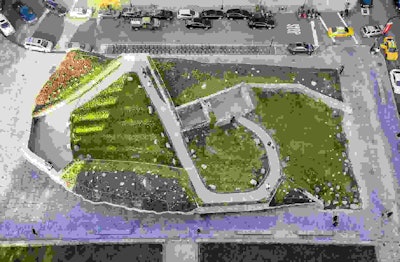 One of the solutions employed to waterproof the monument was encapsulating its entire cantilevered concrete slab in the Kemper waterproofing membrane.
One of the solutions employed to waterproof the monument was encapsulating its entire cantilevered concrete slab in the Kemper waterproofing membrane.Photo: Edward Menashy
The Irish Hunger Memorial in Manhattan may not be the first landmark that comes to mind when you think of things to visit in New York City, but thanks to the work of CTA Architects and The LiRo Group, along with others, this monument has been restored to its intended appearance.
 Battery Park City Authority, CTA Architects, construction manager The LiRo Group, contractor Nicholson & Galloway and landscape consultant SiteWorks have completed the $5.3 million renovations and waterproofing of the Irish Hunger Memorial.
Battery Park City Authority, CTA Architects, construction manager The LiRo Group, contractor Nicholson & Galloway and landscape consultant SiteWorks have completed the $5.3 million renovations and waterproofing of the Irish Hunger Memorial.Photo: Edward Menashy
The Memorial was created as a contemplative space to honor the Great Irish Hunger and Migration of 1845-1852 and to encourage visitors to consider worldwide hunger issues in the present day as well.
Designed by renowned sculptor and public artist Brian Tolle, the monument was opened in 2002 and is located on the corner of Vesey Street and North End Avenue, in the Battery Park City section of downtown Manhattan.
The monument is on a half-acre site and overlooks the Hudson River. Visitors are transported to winding paths through an Irish landscape, filled with native Irish plants and stones imported from each of Ireland’s 32 counties. Along the way, individuals encounter an authentic Irish Famine-era stone cottage that was donated by Tolle’s extended family the Slack of Attymass from County Mayo.
The cottage was dismantled and brought over from Ireland and rebuilt within the hillside of the Memorial. After passing through the cottage, visitors will reach a viewing point that is elevated 25 feet above street level that includes a vista of the Statue of Liberty and Ellis Island.
The meadows, cottage and pathways are all cantilevered over a layered base of glass and polished fossil-bed limestone from County Kilkenny, Ireland. Text relating to the Famine and current hunger issues are listed on the glass panels and wrap around the monument and lead into the passageway to the cottage.
The problem
 The architects found a mineral surfacing system approved by Kemper that matched the finish of the concrete slab and incorporated it into the membrane. It completely hides the waterproofing, maintaining visual consistency with the original slab.
The architects found a mineral surfacing system approved by Kemper that matched the finish of the concrete slab and incorporated it into the membrane. It completely hides the waterproofing, maintaining visual consistency with the original slab.Photo: Edward Menashy
Not long after the Memorial was first opened to the public, the Battery Park City Authority (BPCA) noticed cracking and leaking from the cantilevered slab where the cottage and the landscaping were.
It was soon found that the leaks were infiltrating the electrical space underneath the monument where the glass display case panels and lights were located. An attempt to waterproof a portion of the Memorial was ineffective, and the leaks caused efflorescence staining on the glass panels and discolored the cantilevered slab. The skirt of the slab and some of the limestone base panels were stained as well.
BPCA turned to CTA, which suggested a comprehensive solution that would solve the leaks and keep the Memorial impervious to weather for many years.
“Our team recommended carefully removing the landscaping surrounding field-stone masonry walls and portions of the cottage, removing the previously applied and ineffective waterproofing system, performing limited slab repairs and patching, reconfiguration of and reinforcement of the concealed core walls and substrates, then installing a waterproofing membrane and then assembling the elements of the monument back together,” said Frank Scanlon, CTA’s associate and project manager for the Memorial.
The solution
After Tolle approved the technical solutions, work began in August 2016.
“At the start of the renovation, the project team performed a photographic survey of every inch of every element of the Memorial,” said Frank S. Franco, LiRo vice president and senior project manager. “All elements, including every single stone, were numbered and then removed, cataloged and stored in containers on site during the renovation. This ensured that the team put each piece back in its correct place and position.”
The soil was stripped from the site and saved for reuse while 2,000 square feet of reinforced, cold-applied, liquid Kemper 2K PUR system was applied all over exposed core walls and substrates.
Part of the plan was to encapsulate the edges of the slab in the waterproof membrane for additional protection, but Tolle expressed concern since this would be visible.
“So we found a mineral surfacing system approved by Kemper that matched the finish on the concrete slab and we incorporated it into the membrane,” said Pericle Gheorghias, CTA’s senior technical designer on the project. “It completely hides the waterproofing maintaining visual consistency with the original slab.”
CTA also added a custom masonry anchoring system for the fieldstone-and-rubble wall that was installed over a sturdy concrete masonry unit core. The system was incorporated to keep the irregularly shaped stones in place within the fieldstone wall. Minor masonry restoration was also carried out on the cottage.
The true challenge of the project was ensuring the meadow could function as a field with its own living ecosystem while being located on top of a waterproof concrete slab.
 Photo: Edward Menashy
Photo: Edward MenashyCTA worked closely with landscape consultant and architect SiteWorks to document the existing plant material that had to be contract grown. The square footage of the planted area is 7,200 square feet and the original planting consisted of 90,000 plugs of native grasses and 52 different types of plants.
SiteWorks conducted a topographic survey to document the furrows and its existing conditions survey included points taken every three feet. This was crucial for creating a base for the soil profiles and irrigation layout.
“Many of us on the project have strong ties to Ireland, making this much more than basic renovation work to us,” said Daniel J. Allen, principal at CTA. “We were painstaking in our repairs in order to keep the artist’s vision intact.”
The team worked to ensure the existing soils could be reused and were kept off-site and when the soils became homogeneous over time, organic matter was added to make up the top layer. The plants, which are all native to Ireland, were also grown off-site and replanted once the renovation was completed.
“We recommended that the plants begin growing early in the construction phase, as it would take a minimum of one year for them to grow to the point that they are viable,” said James Dudley, a SiteWorks senior project manager.
The plant life included 19 varieties of herbaceous annuals and perennials; 18 types of grasses, rushes and sedges; eight varieties of dwarf shrubs and wood plants; and six Clematis vitalba vines.
“The Memorial’s irrigation system was designed to address both the site’s slope and the use of fast-draining soils,” said Paul Ersboll, LiRo senior design manager. “It comprises a combination of rotor spray heads that irrigate the upper and middle furrow, and dripperline tubing that irrigates the slope-edge plantings. As the edge planters are on a steep slope, the team added jute netting on top of the drainage layer and wrapped it to contain the soil layers until the new plant material is established.”
The renovation cost $5.3 million and CTA worked along with contractor Nicholson & Galloway, Inc. and mechanical, electrical and plumbing (M/E/P) engineer Collado Engineering, P.C. and structural engineer GACE Consulting Engineers to see the project completed.
“The Irish Hunger Memorial was first dedicated over 15 years ago; it has now re-opened to stand for coming generations as a place of reflection and remembrance,” said the Battery Park City Authority. “And just as America has long welcomed immigrants from Ireland and beyond, we’re pleased to once again welcome Battery Park visitors to experience this poignant tribute to the unbreakable human spirit.”
 The 96′ x 170′ Memorial winds through a rural Irish landscape, with paths carved into a hill thickly lined with native Irish plants and stones imported from each of Ireland’s 32 counties.
The 96′ x 170′ Memorial winds through a rural Irish landscape, with paths carved into a hill thickly lined with native Irish plants and stones imported from each of Ireland’s 32 counties.Photo: Edward Menashy









